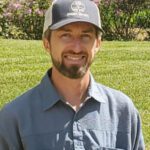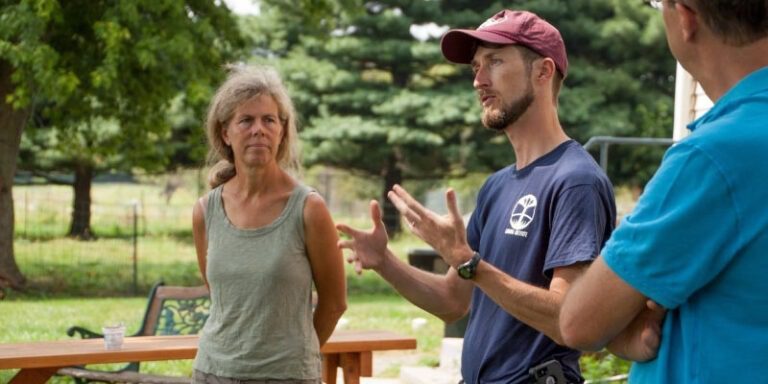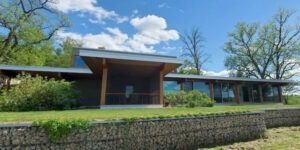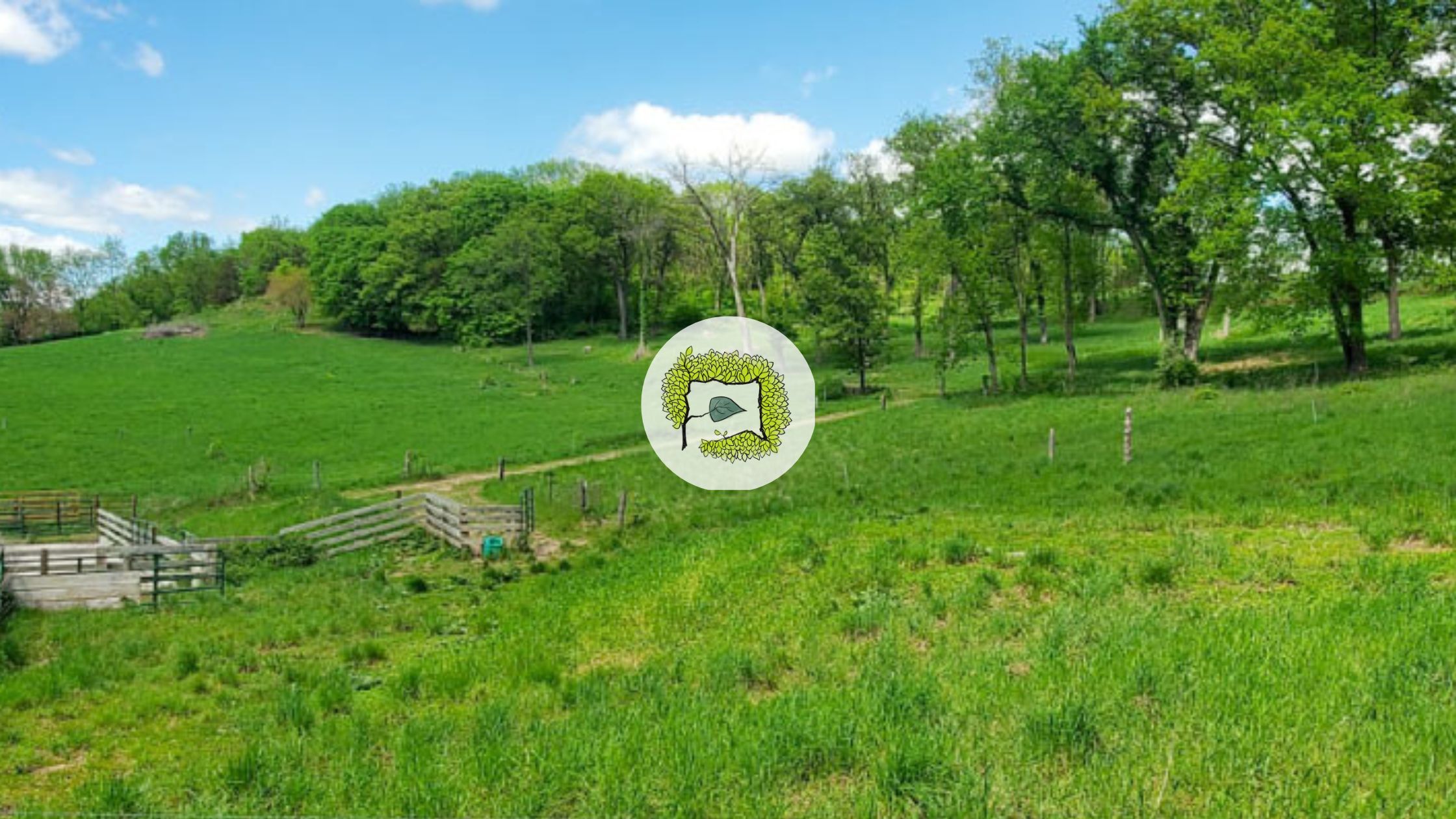 “We’re building the new in the shadow of the old,” Keefe Keeley MS’14, PhD’21 mused as we meandered about the fields and woodlands of the Savanna Institute’s North Farm, five miles from Spring Green, Wisconsin. Our walk took us among young walnut trees, cedars, hayfields and newly sown rye in the shadow of a ridgetop forest. In the valley, hazelnut saplings had recently been planted in recurring strips between plots of alfalfa ground cover. “We’re working toward a perennialization of agriculture, plus some,” Keeley added.
“We’re building the new in the shadow of the old,” Keefe Keeley MS’14, PhD’21 mused as we meandered about the fields and woodlands of the Savanna Institute’s North Farm, five miles from Spring Green, Wisconsin. Our walk took us among young walnut trees, cedars, hayfields and newly sown rye in the shadow of a ridgetop forest. In the valley, hazelnut saplings had recently been planted in recurring strips between plots of alfalfa ground cover. “We’re working toward a perennialization of agriculture, plus some,” Keeley added.

Keefe Keeley MS’14, PhD’21 is one of six Nelson Institute alumni award winners. This story was originally published by Kevin Koch, professor of English at Loras College.
Keeley is the executive director of the Savanna Institute, a Southwest Wisconsin-based nonprofit organization promoting agroforestry, or the incorporation of forestry into Midwest farming. Trees protect against soil erosion, keep nutrient runoff from entering local streams, and provide windbreaks, shade for cattle, and wildlife habitat. Sometimes the timber and tree fruits are crops themselves. All this while sequestering carbon in the fight against climate change. Keeley knows a thing or two about agroforestry and agroecology: he earned both his master’s and PhD in agroecology through UW–Madison’s Nelson Institute.
Savanna Institute’s origins trace back to 2013 in central Illinois as forestry and agriculture graduate students at the University of Illinois at Champaign–Urbana began working with community farmers to explore more diverse, economically viable options for farming. They hoped to shift away from the typical monoculture row crop model, explore markets for new crops, and make agriculture part of the climate change solution.
We work collaboratively to heal the climate, repair the land, and strengthen communities by advancing agroforestry—a time-tested system of farming with trees and building resilience through deep-rooted diversity.”
– Keefe Keeley, Executive Director of the Savanna Institute
While completing his master’s degree, Keeley joined Savanna Institute in 2013 as its first director. Now centered in Spring Green, Savanna Institute has grown from having Keeley as its sole (part-time) employee to a current full-time staff of 31 whose positions range from biological and soil scientists to marketing and community outreach specialists to hands-on farming experts on its four recently acquired agricultural properties in the Spring Green area.
Spring Green is part of the Driftless Area, an ecological curiosity that stayed unglaciated during the Ice Age, thus lacking in the glacial drifts seen throughout the rest of the state. This region is another thing that Keeley knows well: while working toward his PhD, he coedited a book about the interwoven human and natural history of the region. In addition to its location, Savanna Institute takes its name from the prevailing ecosystem that graced the Driftless Area prior to Euro-American settlement: the oak savanna. Savannas were not quite forests, not quite open prairie. In oak savannas, hardwood oaks and hickories dotted the landscape in groves or solitary stands with prairie grasses and wildflowers growing beneath and between them.
That’s where the “old” and “new” come in. Keeley points out that Indigenous peoples farmed amid the savanna, and even the earliest Euro-American pioneers kept much of the surrounding woodland intact. But economic pressures eventually led to mechanized, fencerow-to-fencerow farming. Agroforestry revives “old” paradigms of maintaining and tending trees in an agricultural setting. The “new” comes from modern research methods for studying and breeding the best combinations of trees and row crops.
Noting that farmers are constrained by enormous economic pressures, Keeley emphasizes that the Savanna Institute is “not wagging a finger at anyone” in regard to conventional modern agricultural practices. Rather, the goal of the organization is to “put some new tools in the farming toolbox.”
Savanna Institute purchased what they call the North Farm in 2020. The farm’s seller was interested in the organization’s conservation mission. He had already planted a walnut grove on the upslopes of the farm property and helped place a conservation easement on part of the property that lay along the Wisconsin River to preserve its marshy backwaters as habitat for migrating waterfowl.

Keeley found that the Spring Green farming community was equally supportive of Savanna Institute’s goals. In fact, local conservation-minded landowners helped recruit Savanna Institute as a buyer and contributed toward the purchase. “Southwest Wisconsin offered a community already engaged in conservation and agricultural innovation. They were already pushing the envelope of what 21st century agriculture might look like,” Keeley says, with their interests in organic farming, rotational farming, farmer-led watershed groups, and community-supported agriculture (or CSAs). Many in the region were already practicing Aldo Leopold’s maxim “to live on a piece of land without spoiling it,” he adds.
North Farm serves as a working commercial farm, demonstrating what agroforestry might look like, how mechanization fits in, and how economic realities can be met. As we walked along the hazelnut plantings in the alfalfa field, Keeley talked about land equivalency ratios. Scientific agricultural studies have shown that tree crops and row crops grown separately may take 1.4 acres to produce what can typically be grown on one acre when intermingled. Tree and row crops often mature at different times, meaning that harvesting the one crop won’t disturb the other. And since their roots are deeper, trees can actually help row crops by bringing water up to the surface level even beyond what they use themselves.
And there is the added benefit to wildlife. As we toured, we encountered butterflies in the alfalfa and a hummingbird among the hazelnut plantings. Keeley loves to hear the insect and bird songs amid the fields.

The Wright-inspired home at Hillside Farm will serve as a community events center and a meeting place for Savanna Institute.
North Farm is 331 acres, including 200 acres of woodland. But three other recently purchased farmsteads bring Savana Institute’s total to 778 acres. Valley Farm, located in the sandy flood plain of the Wisconsin River, will be devoted to tree crop research using cutting-edge agricultural science. Located near popular tourist destinations like Frank Lloyd Wright’s Taliesin and the American Players Theatre, South Farm will serve an educational purpose, introducing the general public to agroforestry.
The newest acquisition, Hillside Farm, is a sylvan pasture cattle ranch obtained just this past March. Here, Keeley explains, the goal will be to study the effects of grazing cattle in an existing oak savanna. But Hillside Farm is also arguably the most aesthetic of the four properties. A short hike up to its commanding wooded bluff reveals a view of Taliesin in the distance, and sweeping woods, farm fields, and lightly traveled roads in every direction. The previous owner had built a sprawling, light-infused, Wright-inspired house that will serve as a community events center and a meeting place for the Savanna Institute.
Keeley laments that in the face of climate change and other environmental threats, “people feel pretty powerless, and are typically told to do less.” Savanna Institute, he says, asks instead, “What’s the positive action where we can do more, and have healthier food and better farming economies as well?”

